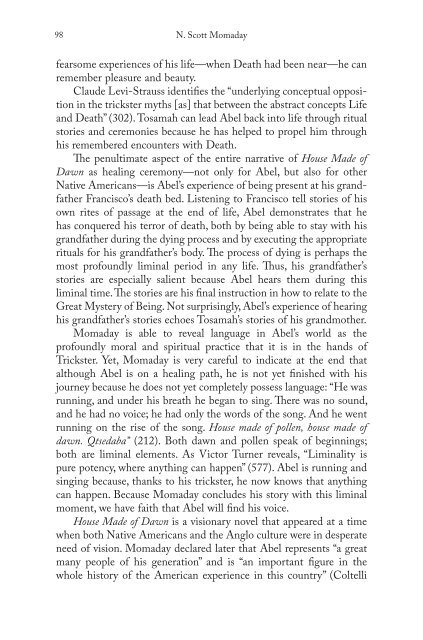Blooms Literary Themes - THE TRICKSTER.pdf - ymerleksi - home
Blooms Literary Themes - THE TRICKSTER.pdf - ymerleksi - home
Blooms Literary Themes - THE TRICKSTER.pdf - ymerleksi - home
You also want an ePaper? Increase the reach of your titles
YUMPU automatically turns print PDFs into web optimized ePapers that Google loves.
98<br />
N. Scott Momaday<br />
fearsome experiences of his life—when Death had been near—he can<br />
remember pleasure and beauty.<br />
Claude Levi-Strauss identifi es the “underlying conceptual opposition<br />
in the trickster myths [as] that between the abstract concepts Life<br />
and Death” (302). Tosamah can lead Abel back into life through ritual<br />
stories and ceremonies because he has helped to propel him through<br />
his remembered encounters with Death.<br />
Th e penultimate aspect of the entire narrative of House Made of<br />
Dawn as healing ceremony—not only for Abel, but also for other<br />
Native Americans—is Abel’s experience of being present at his grandfather<br />
Francisco’s death bed. Listening to Francisco tell stories of his<br />
own rites of passage at the end of life, Abel demonstrates that he<br />
has conquered his terror of death, both by being able to stay with his<br />
grandfather during the dying process and by executing the appropriate<br />
rituals for his grandfather’s body. Th e process of dying is perhaps the<br />
most profoundly liminal period in any life. Th us, his grandfather’s<br />
stories are especially salient because Abel hears them during this<br />
liminal time. Th e stories are his fi nal instruction in how to relate to the<br />
Great Mystery of Being. Not surprisingly, Abel’s experience of hearing<br />
his grandfather’s stories echoes Tosamah’s stories of his grandmother.<br />
Momaday is able to reveal language in Abel’s world as the<br />
profoundly moral and spiritual practice that it is in the hands of<br />
Trickster. Yet, Momaday is very careful to indicate at the end that<br />
although Abel is on a healing path, he is not yet fi nished with his<br />
journey because he does not yet completely possess language: “He was<br />
running, and under his breath he began to sing. Th ere was no sound,<br />
and he had no voice; he had only the words of the song. And he went<br />
running on the rise of the song. House made of pollen, house made of<br />
dawn. Qtsedaba” (212). Both dawn and pollen speak of beginnings;<br />
both are liminal elements. As Victor Turner reveals, “Liminality is<br />
pure potency, where anything can happen” (577). Abel is running and<br />
singing because, thanks to his trickster, he now knows that anything<br />
can happen. Because Momaday concludes his story with this liminal<br />
moment, we have faith that Abel will fi nd his voice.<br />
House Made of Dawn is a visionary novel that appeared at a time<br />
when both Native Americans and the Anglo culture were in desperate<br />
need of vision. Momaday declared later that Abel represents “a great<br />
many people of his generation” and is “an important fi gure in the<br />
whole history of the American experience in this country” (Coltelli

















